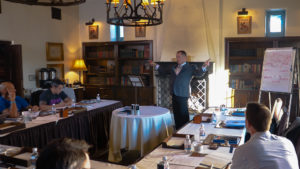If you’re like most people, including myself, you’ve had a misunderstanding at work. In fact, you were very confident of your clarity, you can hear yourself confirming understanding, and then there’s a follow-up that makes you feel like you might have imagined it all.
Communicating can be incredibly frustrating, especially when it requires significant effort. Yet, this is the essence of executive communication skills. It’s not a one-time occurrence but rather an ongoing process of conversation, confirmation, and affirmation.
Clearing up a misunderstanding at work is difficult when real or perceived authority gets in the way of an open conversation to resolve the issue. Effective communication in healthcare is a clear example of a perceived hierarchy that can hinder essential information. Perhaps you’ve had a leader who said something incorrect but with such confidence that you assumed they were right. Maybe that person is you.
As a Certified Conflict Management Coach, here are some tips you can use to resolve any misunderstanding, leaving everyone feeling better about themselves after having communicated effectively.

Tip #1: Assume you’re wrong.
People are often advised to assume positive intent when asking how to be a better communicator. However, I’ve found that that phrase is frequently quoted with a sarcastic tone accompanied by an eye-roll.
That means you’re already in a suspicious state of mind.
Instead, reset yourself by assuming that you are incorrect and seek information that proves that point. You will be in a heightened state of listening to hear why you have misunderstood, mishear, or misinterpreted the entire situation.
TIP: With a relentless focus on the other person, you will hear nuance, subtlety, and additional facts you may have missed during the first interaction, meeting, or conversation.
This tip is designed to hone your focus, seek understanding, and release any preconceived notions you had about debating a point instead of resolving a conflict.

Tip #2: Look for the 10%.
Perhaps it’s a leap for you to assume your read of the situation is entirely wrong.
TIP: Instead, look for how that other person might be just ten percent correct in their interpretation.
This tip is designed to trigger your curiosity because you’re letting yourself be mostly “right” yet seeking that small aspect that the other person got right.
Using the 10% crowbar to let go of absolutism will help you bridge the gap between conflict and understanding. Through your behavior, the other person can sense the effort and give you the benefit of the doubt. As you both relax your grip, you move toward a win/win outcome.

Tip #3: Be empathetic.
You might be wondering why empathy wasn’t first.
It’s a learned skill that is easier for some than others, so this tip wins the third slot. You might have a parent or relative who has weighed in when you’ve cursed a driver that cut you off by offering the perspective that that person might be driving a loved one to the emergency room. That’s empathy combined with an assumption that you misread the situation.
When confronted by a situation at work that seems like you’ve misunderstood each other, be empathetic for that person.
Are they under substantial pressure to deliver results?
Their workload may be especially fierce.
What if they have an ill loved one that is weighing on them?
TIP: We simply cannot know what’s beneath the surface unless they share it, so lead with empathy for all you may not know.
There is no downside to treating someone with compassion.
Sometimes, the tips, techniques, and tools of executive communication coaching can seem time-consuming. You may have thought, “I don’t have time for that, and people just need to do their jobs.” This is a common dismissal of investing in communication and conflict resolution.
Data suggests that companies with strong communication ecosystems enjoy more profitability. How so? They are more collaborative, resolve issues more quickly, and foster a culture of retention from their efforts.
If you’ve ever wondered how working with a coach can build a stronger team, improve results, and solidify culture, reach out and schedule a 15-minute meet-and-greet to see if we click.
Are you already intrigued and want to click some tires? Then, take advantage of a complimentary Talent Dynamics assessment and debrief for your entire leadership team. You will leave our session with self-awareness and a profoundly better understanding of the unique talents of the others on your team. Click here to schedule a time today.




